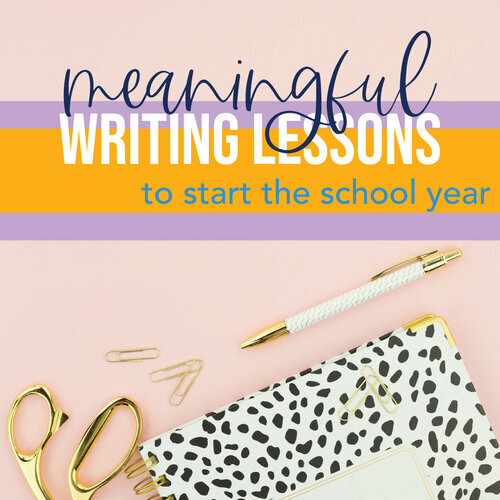Meaningful Writing Lessons to Start the School Year
When English teachers think of their students as writers, we have pretty pictures in our head. (We do, don’t we?)
Teachers want meaningful writing lessons.
We want eager writers, writers who are ready to change the world. We envision students poring over notebooks. Whatever magic Hollywood creates, we want it.
I’ve never created perfection, but I do see improvement in student writing. By the end of the school year, students will share sentiments that “they can do it.” Students enter their writing in contests, and others ask for their writing to be sent to home emails.
I count all of those as wins. As I embark on a new school year, I am reflecting on the start of the year and where I have found success.
With those first writing assignments, I establish trust, ease fear, and give choice. I build relationships while setting high expectations.
Below, I have broken down what helps me.
Ease fear
Students fear being “wrong” with writing, and by showing students the fast ways to write, we are showing students that we trust them to write. For our first writing assignments, we complete smaller and fun writing assignments.
I model writing for students, and I stress with them that everyone has a personal process. No two processes are the same. All writers create their own discoveries. With small assignments, students see success, I can model the process, and I can gauge where students need prompting.
Actually, I feel my biggest job as a writing teacher is to help students discover their process and groove. Showing students they aren’t writing incorrectly eases their fears.
Establish trust
I don’t want students to be surprised by me. In fact, students enjoy routines and procedures because they trust that you will guide them and keep them safe.
The same concept applies to writing lessons: when students know your expectations, when you share common terms, when they see writing examples, that establishes trust. Students trust that your expectations can be met, that you are giving them a fair deal.
Consider this. You have a classroom of students, many with varying school experiences. Some use the term “topic sentence” while others use “sub-claim.” Others use “transitions” for conjunctions, and they become confused during lessons on punctuation.
I provide students with the terms I use with writing. I never want students sitting in my class, stuck because they are unfamiliar with my vocabulary. I establish that students can trust me; we are on the same page.
In a digital classroom, students and parents have a document to reference. I always answer emails, but if a student is working an odd hour of the day, I might not be available. It helps relationships and eliminates frustrations to have expectations and definitions in one location.
Build community
Students won’t relax and write if they are nervous. After modeling and talking to to ease fear and establishing trust, I focus on building community. I make an effort to create a memorable writing experience (those meaningful writing lessons!) by organizing a paper on cookies.
Yes, the butter and sugar and flour type of cookie.
Think: all students have tasted cookies and have different experiences. They are comfortable with this topic and can write at length for different genres. We can practice brainstorming, organizing, and drafting. Not only do I build community, but I also create a memorable activity that I can reference the rest of the school year. If I student struggles to brainstorm, I can say, “Remember the long list we developed after mentioning chocolate chip cookies?” When students need to organize a paper, I can reference the way we organized large topics like types of cookies, ingredients, holidays, and more. I always have a happy memory I can relate to current papers.
Plus? We eat cookies and build community. My writing community starts with a cookie paper.
As I dive into my twelve year of teaching, I know what students need to become the fabulous writers I envision. I need to establish trust and ease their fears. We need to build a writing community where collaboration and feedback is a natural step in the writing process. All pieces must work together, and I’ll start shaping that the community the first day I meet my students with meaningful writing lessons.
Interested in more writing activities? All activities (and many more!) are included in Lauralee’s Writing Bundle for Freshmen and Sophomores.
Related Posts:
How to get teens to enjoy writing
How to celebrate mistakes to build a stronger writing community
Ten writing assignments to build a writing community in the classroom
About the Author
Lauralee Moss is the author of The English Grammar Workbook and creator of Language Arts Classroom. She teaches high school English in Illinois. You can find her on Instagram or Teachers Pay Teachers.
You may be interested in:



